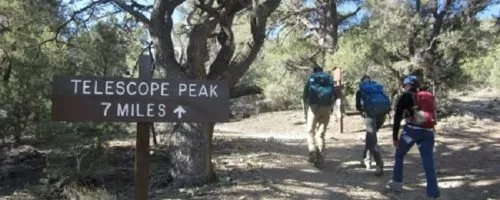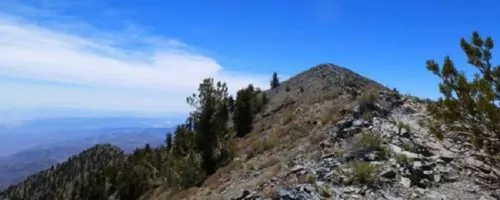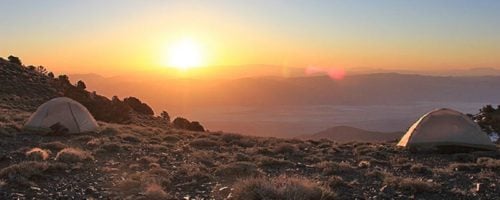
Telescope Peak Trail
General Description
A hike to the magnificent Telescope Peak is a challenging thrill ride that is sure to get your heart pumping. The highest point in Death Valley National Park, Telescope peak stands over 11,300 feet above the valley floor just 7 miles east. You would literally have to be in an airplane to be so far above the ground! The trail begins at Mahogany Flat where hikers catch their first views back into Badwater Basin over 8000 feet below. Hike around Rogers and Bennett Peaks, taking in views of the Eastern Sierras to the west. Breathe deep and take your time up the 13 steep switchbacks to the final ridgeline to the breathtaking summit. Be sure to sign the summit register and take time to admire the stunning 360 panorama and celebrate your victory. You’ve earned it.
Explore Death Valley with Expert Guides
Getting to the Telescope Peak Trailhead
From Furnace Creek Village take CA-190 West approximately 33.5 miles to a left turn on Emigrant Canyon Road. From Panamint Springs, it is just over 21 miles East on CA-190 to a right turn on Emigrant Canyon Road.From the turnoff carefully drive the narrow, crooked 29.8 miles past the Wildrose Campground to the Mahogany Flat Campground. During the winter months, the road may be closed at the Wildrose Charcoal Kilns adding 4 miles to the roundtrip hike.

3 Best Day Hikes Near the Telescope Peak Trail
Telescope Peak is the crown jewel of peak hikes, but don’t miss out on these other fantastic hikes in Death Valley National Park.
| Destination | Miles | Elev | Difficulty | Style | |
| Mesquite Flat Sand Dunes | N/A | <100 | Easy | Out and Back | |
| Darwin Falls | 2 mi | 200 ft | Easy | Out and Back | |
| Mosaic Canyon | 3.5 mi | 1000 ft | Easy-Moderate | Out and Back |
1. Mesquite Flat Sand Dunes
The Mesquite Flats Sand Dunes are truly a sight of wonder and amazement, a trove of cinematic history, and a playground for kids and the young at heart. Located just on the outskirts of the village of Stovepipe Wells, the dunes are a great place to romp, play, and explore. Early risers witness the surrounding mountains set ablaze with the rising sun. A perch atop the tallest dune, at over 200 feet high, is a sublime place to watch the ember glow of daylight fade. Take a sled or sandboard and shred the steeper dunes by the light of the full moon. There’s almost no wrong way to experience the Mesquite Flats Sand Dunes in Death Valley National Park. There are no official trails in the dunes, so explore to your heart’s content. Let your inner child run wild and have fun in nature’s sand box.
2. Darwin Falls
Darwin Falls is an unbelievably beautiful and welcome anomaly in Death Valley National Park. The hike begins like many others, in a gravelly, barren wash typical of Death Valley’s bone-dry landscape. Suddenly, a lush canyon alive with willows, cottonwoods, and birdsong takes shape. Approximately one mile into the hike is Darwin Falls, cascading 25 feet down the lime green algae covered rock. The edge of the pool at the base of the falls is a perfect place to sit and soak it all in. Please avoid the temptation to take a soak yourself. This spring-fed stream is the water source for the nearby hamlet of Panamint Springs. Exercise caution on the hike back. Wet boots and sand can make the smoothly polished rock scrambles quite treacherous. Hikers of all ages will definitely welcome this easy hike to a stunning desert oasis.
3. Mosaic Canyon
Mosaic Canyon is an amazing hike for both first-time and long-time visitors of Death Valley National Park. A two mile drive up the gravel road on the western edge of Stovepipe Wells delivers hikers to the Mosaic Canyon Trailhead. The walls of smoothly polished marble immediately come together forming a short, stunning, tortuous narrows. Along the way, you may notice the mosaic-like breccia for which the canyon is named. Beyond these narrows, the canyon opens to a large wash, but the fun doesn’t have to end here. Several primitive trails work their way up the canyon to even more narrows, dry falls, and other fun discoveries. Mosaic Canyon is a perfect hike for families and seasoned desert hikers alike.
Maximize Your Visit to Death Valley National Park on a Hiking Tour
Guided multi-day packages allow visitors the opportunity to make the most of their time in Death Valley National Park and to do it hassle-free. Guided tours include gear (backpack, trekking poles, crampons in winter), meals, accommodations, local transportation, and a professional Death Valley hiking guide. Through their knowledge, stories, and personal passion, guides can bring a place to life in a way that’s much more difficult to do on your own. Read more about Death Valley Hiking Tours.
Award Winning USA Hiking Vacations

More Great Peak Hikes
Telescope Peak may be the ultimate peak to bag in Death Valley National Park, but don’t stop there. Maximize your time in Death Valley National park with these other unbelievable peaks.
| Destination | Miles | Elev | Difficulty | Style | |
| Wildrose Peak | 8.4 mi | 2200 ft | Moderate | Out and Back | |
| Thimble Peak | 3 mi | 1600 ft | Moderate- Strenuous | Out and Back | |
1. Wildrose Peak
Wildrose Peak Trail is perfect for the weekend peak bagger or anyone seeking a challenging day hike. The trailhead starts at the beautifully preserved historic Charcoal Kilns. From here, hikers follow the remnants of the old logging road to a saddle to stunning views of the Badwater Basin salt flats. Take a minute to catch that second wind before the steep ascent to the summit. A series of tight switchbacks wind their way up the side of the mountain in full view of the valley floor over 8000 feet below. Enjoy a few moments of triumph at the summit just over 9000 feet above sea level. A sweeping panorama reveals Death Valley stretching east and north, Telescope and Rogers peaks towering to the south, and the mighty Sierra Nevada to the west. Write a few inspiring words in the summit register, and enjoy the views.
2. Thimble Peak
If you happen to be taking a drive on the amazing Titus Canyon Road, then why not take a break and bag an equally amazing peak. At just 5 miles round trip and a little over 1300 feet of total elevation gain, Thimble Peak is the best high return hike for minimal effort in Death Valley National Park. The trail begins on the south side of Red Pass (you’ll know when you get there). From here, follow the well-worn path up the ridgeline to the base of Thimble’s sheer limestone cliffs. It may look intimidating initially, but the path is a series of careful switchbacks straight up the northern ridge. From the summit, the outstanding views rival those from even Telescope Peak. Although it is a relatively tame hike, exercise extreme caution on the final approach as it involves some steep, loose, and partially exposed scrambles. Enjoy the view!
Join a Guided Death Valley National Park Backpacking Trip
Joining a Death Valley backpacking tour is a worry-free, adventurous way to experience Death Valley National Park. With your gear, meals, local transportation, permits, and fees taken care of for you, you can travel light and focus 100% on enjoying the hiking experience, while the guide company takes care of everything else. Also, by going with local experts you’ll enjoy a greater level of safety and gain a much better understanding of the history and ecology of this remarkable region. Read more about a guided Death Valley National Park backpacking trip.
All-inclusive Death Valley Backpacking Adventures

When to Hike and Seasonal Considerations
Telescope Peak is best hiked from late spring to early winter. If ice and snow are present, snowshoes and/or crampons are advised. Check road conditions before you go. The final two miles of the Emigrant Canyon Road from the Wildrose Charcoal Kilns to Mahogany Flat is closed from November to March. Camping at least one night at Mahogany Flat campground prior to your hike to Telescope Peak is usually a good idea to get acclimated to the elevation.
Necessary Permits
Day Hikes
No permits are required for day hiking in Death Valley National Park.
Backpacking Permits
Backcountry camping permits are voluntary and may be obtained at the Visitor Center or any Ranger Station. Due to the extreme environment and remoteness, it is recommended that solo hikers and backpackers provide itinerary information and emergency contacts to park personnel.
Suggested Packing List
Day Hike Packing List
- 3-4 liters of water per person
- Salty, calorie-rich snacks
- lunch
- backpack
- trekking poles
- crampons (in winter)
- wide-brimmed hat
- sunscreen, sunglasses
- cotton t-shirt (spring-fall)
- non-cotton t-shirt (winter)
- rain jacket
- warm non-cotton layer
- 1st-aid kit
Backpacking Packing List
- all items listed for day hikes PLUS
- additional water AND water filter/purification method
- multi-day backpack
- 3-season tent
- sleeping bag
- sleeping pad
- backpacking stove and fuel
- backpacking meals
- 2-3 pairs wool socks
- extra t-shirts
Please Respect Our National Parks – Leave No Trace
We strongly recommend abiding by all Leave No Trace ethics guidelines and practices so that our national parks and public lands are preserved for the enjoyment of future generations and for the people and animals who call these places home. Simple things like packing out your trash, obeying national park rules, and respecting the peace and quiet of our national park trails is a great start. If you’re going on a backpacking trip, you can read about more about the 7 Leave No Trace Principles.





